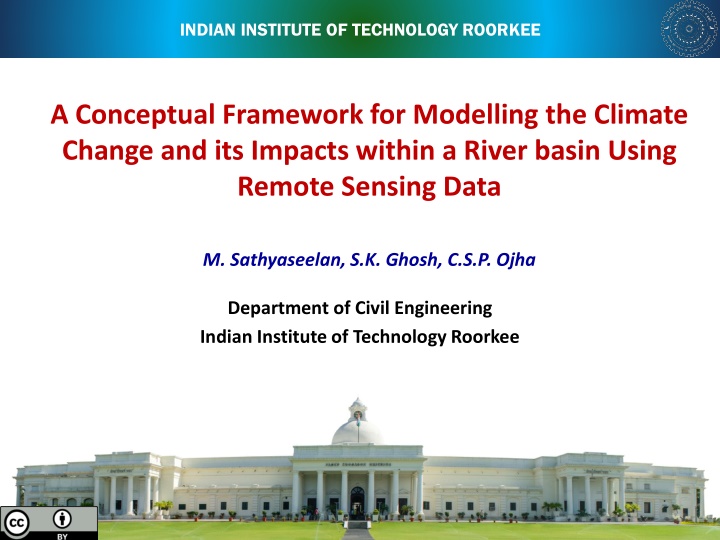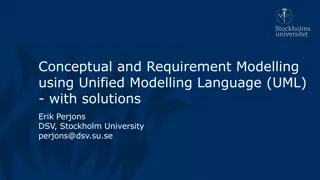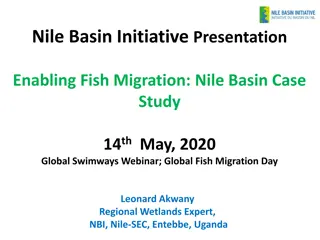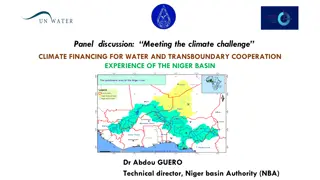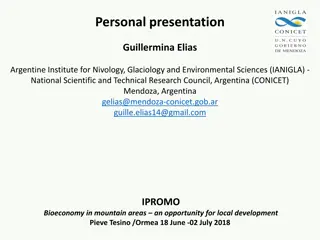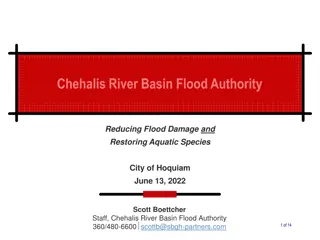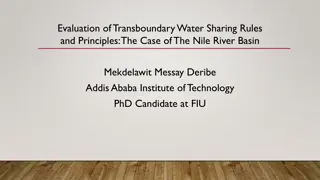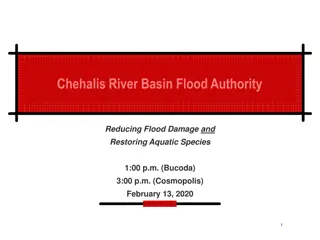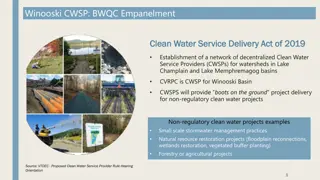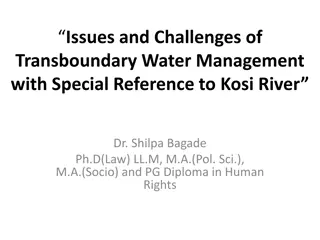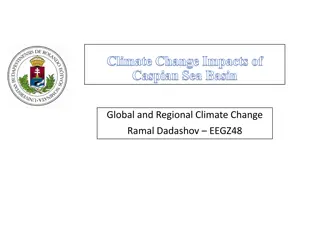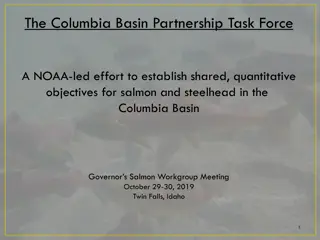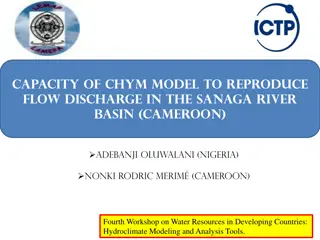Conceptual Framework for Modelling Climate Change Impacts within River Basin Using Remote Sensing Data
Intergovernmental Panel for Climate Change's assessment reports highlight the significance of global warming and its impacts on hydrological cycles. This research from the Indian Institute of Technology Roorkee presents an integrated framework for modeling climate change effects within a river basin scale. Explore the components - data, process, impact, uncertainty, and feedback - essential for efficient water resource management. This study delves into hydro-climatic data, land surface data, simulated data, and impact dynamics to understand the complex nature of climate change adaptation.
Uploaded on Apr 04, 2025 | 8 Views
Download Presentation

Please find below an Image/Link to download the presentation.
The content on the website is provided AS IS for your information and personal use only. It may not be sold, licensed, or shared on other websites without obtaining consent from the author.If you encounter any issues during the download, it is possible that the publisher has removed the file from their server.
You are allowed to download the files provided on this website for personal or commercial use, subject to the condition that they are used lawfully. All files are the property of their respective owners.
The content on the website is provided AS IS for your information and personal use only. It may not be sold, licensed, or shared on other websites without obtaining consent from the author.
E N D
Presentation Transcript
INDIAN INSTITUTE OF TECHNOLOGY ROORKEE A Conceptual Framework for Modelling the Climate Change and its Impacts within a River basin Using Remote Sensing Data M. Sathyaseelan, S.K. Ghosh, C.S.P. Ojha Department of Civil Engineering Indian Institute of Technology Roorkee
Overview Introduction 1 Conceptual Framework 2 Data Component 3 Process Component 4 Impact Component 5 Uncertainty Component 6 Feedback Component 7 Conclusion 8 2
Introduction The Intergovernmental Panel for Climate Change 5thassessment report (IPCC AR5) states that 21stcentury may have an increase in Global warming of ~1.5 C (IPCC AR5, 2019). Global Climate Change is the key factor that create impacts on hydrological cycle at various stages (Bharati et al., 2011; Immerzeel et al., 2013; Surampalli et al., 2015). Climate change and its adaptation measures all over the world are still under research because of its complex and dynamics nature (Singh et al., 1997;; Adler et al., 2019). An integrated framework for modelling the Climate Change and its impacts within a river basin scale may help to manage the water resources efficiently. The conceptual framework consists of a data component, process component, impact component, uncertainty component and feedback component. 3
General Conceptual Framework Simulated Hydro-Climatic Data Hydrological Data Land Surface Data GCM/RCM/Projected Data River/ Waterbodies Precipitation Topography/DEM CORDEX Temperature Landuse/land cover Discharge CMIP Evapotranspiration Soil type Data Flow level NCEP/NOAA Relative humidity Component Soil Moisture Wind Speed WRF Reservoir Level Impact on Land Uncertainty Component Landuse/land cover dynamics Impact Component Process Component Land Unpredictable Glacier/Snow dynamics Processes Atmospheric and Ocean Processes Feedback Component Impact on Water Impact on Atmosphere & Ocean Reduction in the water availability Increased Extreme rainfall events. Reduction in Rainfall amount. Anomaly in Sea Surface Temperature. Hydrological Processes Changes observed in the hydrological response of a river basin. 4
Data Component Topography / DEM SRTM, ASTER, Cartosat, ALOSPalSAR Precipitation IMD, CRU, TRMM, GPM, PERSIANN, MERRA Temperature - TM, MODIS Terra & Aqua, AVHRR LULC Landsat, Sentinel, IRS, MODIS Terra, AWiFS Evapotranspiration- MODIS ET, MERRA Soil Landsat, MODIS Wind Speed - GEOS, Meteosat, Quick SCAT, Kalpana (GEO), Soil Moisture Landsat, Sentinel, IRS, MODIS Terra, AWiFS, SMAP, RISAT, INSAT-3D (GEO) Hydro-Climatic Data Land Surface Data Data Component Hydrological Data Projected Data CMIP5 Waterbodies/ River extraction CORDEX Discharge NCEP Flow Level WRF Reservoir level 5
Process Component - Atmospheric Process Process - I Precipitation Climate Change detection Trend exists Yes Trend analysis Seasonality Exist ? If Yes Spatial Analysis on Climatic Trends Temperature Highly dynamic to detect trend and Hence assumed as trend does not exists Long Term Data Short term Data No Process - II Statistical Downscaling GCM s Initial Boundary Conditions PBL-SST, CC Desired weather data parameters at a higher spatial resolution Atmospheric Model Data Topography, Landuse/ land cover data, Soil Moisture Assimilation Dynamical Downscaling LSM 6
Process Component - Hydrological Process Atmospheric Data/ Process Basin Characteristics Land Surface Data Input Data Basin Delineation Meteorological Data (P, Tmax, Tmin, RH, W, SLR) Topography DEM River Network Geometry LULC Scenarios Basin Morphometry RCP Scenarios 4.5 & 8.5 GCM s Soil moisture Gauge/Discharge Stations Physically based distributed Hydrological Model Simulated Hydrological response (Runoff QSim, Sediment Discharge SSim) Calibration and Validation of Hydrological Model Observed Sediment Discharge SSim) Observed Runoff (QObs) Future hydrological response from the hydrological model run scenarios 7
Impact Component within a River Basin Impact within a River Basin Impact on Water Resources Impact on Soil Moisture Impact on LULC Changes in Hydrological response Changes in Surface area of Waterbodies Forest cover Changes Changes in Crop Yield Snow Cover Dynamics Agricultural land Soil Erosion Aerosols Changes in Wetlands Changes in Water Storage levels Sediment Yield Runoff Increasing frequency of Extreme events Floods Droughts Water Scarcity & Availability Land Degradation & Desertification Environment and Ecosystem Socio-Economic Conditions Food Security Habitation 8
Uncertainty Component Input Data Source Specific Uncertainty Lumped Uncertainty Statistical parameters based Bias Correction (Mean and SD) Meteorological Data Uncertainty Meteorological Data Uncertainty AND OR Hydrological Data Meteorological Data Hydrological Data Uncertainty Hydrological Data Uncertainty Parametric Uncertainty GCM Data Downscaling techniques Ensemble of Hydrological Models Ensemble of GCM s Streamflow generation Precipitation Probabilistic analysis to identify the range values of different variables Routing Process Temperature Identification of the Uncertainty Range of different variables 9
Feedback Component Step 1 Climate model response with respect to Temperature and Radiative forcing Climate Sensitivity Identification of Model parameters based on the sensitivity analysis Feedback component Hydrological Sensitivity Sensitivity Analysis Statistical Significance value for the parameters (P-Value and t-test) Land Surface Sensitivity Step 2 Evapotranspiration Soil Moisture Land Radiative Forcing Solar Irradiance Dust/ Aerosols / Smoke Sensitivity GHG Emissions Atmosphere /Ocean Hydrology Evaporation Water Vapour Relative Humidity Negative Feedback Positive Feedback Feedback Component CO2 Other GHG s Temperature Lapse Rate Cloud Ice Albedo Precipitation Vegetation 10
Conclusion This conceptual framework tries to summarize the possible components required to model the climate change impact within a river basin. This conceptual idea may preferably be developed using open source programming languages for platforms such as Linux, Windows, etc. The use of atmospheric modelling and hydrological modelling requires HPC clusters for faster compilation and parallel processing. Some of the remote sensing based datasets, climate model datasets and modelling algorithms may be directly fetched from online public servers. The use of remote sensing products, GCM s and their downscaled products for the modelling may result in uncertainties. 11
Thanks.. 12
